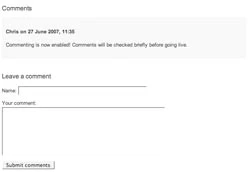: Digital
A very brief update on new media
, 11 April 2008
It's great to be back at the international Museums & The Web conference. The last conference helped shape a lot of the work we've been doing in the last year, so now seems a good time to update you on a few of those developments.
Around this time last year we launched a new blog area. If you haven't seen it yet, click 'refresh' and you're here! Since then we've expanded the feature and published over 70 blog entries. Similarly, we launched our first podcast in October of last year. There's more work to do here and in the short term, you'll see an overhaul of our blog pages and, of course, lots more content.
Tying a lot of things like this together is our new collections site,
. The goal behind Rhagor was to open up our collections and stories to the public in ways that weren't possible before, and really engage visitors with our collections.
The creative process and technical challenges behind our work is sometimes unseen in the final product of an exhibition or an event. We'd also often like to tell you the interesting stories behind our objects without filling our galleries full of text. For me, this really enriches the experience of going to museum for real. We're going to be doing a lot more work to tie our blogs, podcasts and Rhagor features into our visitor pages to give a fuller picture of the work we do.
This is all part of a wider plan we're working on and an evaluation of everything that goes into our site. As always, feedback is welcome. I'll keep you updated as this work develops, but like this time, I'll try to keep it short and sweet!
Engaging Museum Audiences
, 10 April 2008
Keeping the Focus on Learning in e-Learning
, 9 April 2008
Soliciting User Comments
, 14 May 2007
It's been a while since I posted to the New Media blog, but plenty of work has been going into the blog system itself to fix bugs and add features. Building a blog server is less work than you may think if you have enough control over your CMS. For instance, pinging a blog site with your new content is easy using a XML-RPC call - PHP even has a helpful xmlrpc_encode_request function - and a site like Pingomatic will pass the message on to everyone for you
The remaining big feature for us is user comments - I'm not sure we're even a real blog till we enable this. Although the museums I've spoken to haven't experienced problems with comments, most still retain safe-guards. This might be through a registration/email verification system or pre-approving comments to appear on the site. One method favours the regular contributor, the other casual commenters. I haven't seen a system that lets the user decide which they group they belong to, but this might be a good way forward.
Of course, this work could be avoided by installing a blog server like WordPress but by integrating with our in-house content management system (the snappily named Amgueddfa CMS) this work will eventually find its way throughout our site. One of the projects we're working on will introduce lots of interesting articles and other content about our collections. We'd like people to discuss those themes too.
recent entries
Spring Bulbs for Schools Virtual Workshops!
Winter Warmer at the National Wool Museum: Wrap Yourself in the Magic of Wool
Museum Voices: Penny Dacey – Spring Bulbs Project Coordinator
